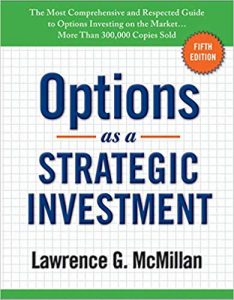Review Options as a Strategic Investment
by Lawrence G. McMillan
Description
Author Lawrence G. McMillan’s “Options as a Strategic Investment” provides readers with an advanced and in-depth guide to managing and investing in listed options and non-equity options. The best-selling title provides options strategies that have been tried and tested in real-world market environments and have been updated in this edition to provide further relevance. Currently, “Options as a Strategic Investment” is intended for investors and traders who already have experience and a background in finance, so newcomers or novice traders may need initial reading or training before tackling this book. Otherwise, this guide is an extended, comprehensive guide into the options strategies as well as tips and tricks on how to benefit when investing in it.
About the Author
Lawrence G. McMillan is the author of Options As a Strategic Investment, the best-selling work on stock and index options strategies, which has sold over 200,000 copies. The fourth edition of this work was released in March 2002. In addition, he has written two other books, McMillan On Options (2nd edition, 2004) and Profit With Options and co-authored another, New Insights On Covered Call Writing. He currently authors a unique daily advisory service – Daily Volume Alerts – which selects short-term stock trades by looking for unusual increases in equity option volume. He also edits and publishes “The Options Strategist,” a derivative product newsletter covering equity, index, and futures options, as well as “The Daily Strategist,” covering much the same strategies but on a daily basis. In addition, he trades his own account actively, and he manages option-oriented accounts for certain individuals. In these capacities, he is the President of McMillan Analysis Corporation, which he founded in 1991.
Table of Contents
- Part I
- Chapter 1 – Definitions
- Part II
- Chapter 2 – Covered Call Writing
- Chapter 3 – Call Buying
- Chapter 4 – Other Call Buying Strategies
- Chapter 5 – Naked Call Writing
- Chapter 6 – Ratio Call Writing
- Chapter 7 – Bull Spreads
- Chapter 8 – Bear Spreads Using Call Options
- Chapter 9 – Calendar Spreads
- Chapter 10 – The Butterfly Spread
- Chapter 11 – Ratio Call Spreads
- Chapter 12 – Combining Calendar and Ratio Spreads
- Chapter 13 – Reverse Spreads
- Chapter 14 – Diagonalizing a Spread
- Part III
- Chapter 15 – Put Option Basics
- Chapter 16 – Put Option Buying
- Chapter 17 – Put Buying in Conjunction with Common Stock Ownership
- Chapter 18 – Buying Puts in Conjunction with Call Purchases
- Chapter 19 – The Sale of a Put
- Chapter 20 – The Sale of a Straddle
- Chapter 21 – Synthetic Stock Positions Created by Puts and Calls
- Chapter 22 – Basic Put Spreads
- Chapter 23 – Spreads Combining Calls and Puts
- Chapter 24 – Ratio Spreads Using Puts
- Chapter 25 – Leaps
- Part IV
- Chapter 26 – Buying Options and Treasury Bills
- Chapter 27 – Arbitrage
- Chapter 28 – Mathematical Applications
- Part V
- Chapter 29 – Introduction to Index Option Products and Futures
- Chapter 30 – Stock Index Hedging Strategies
- Chapter 31 – Index Spreading
- Chapter 32 – Structured Products
- Chapter 33 – Mathematical Considerations for Index Products
- Chapter 34 – Futures and Futures Options
- Chapter 35 – Futures Options Strategies for Futures Spreads
- Part VI
- Chapter 36 – The Basics of Volatility Trading
- Chapter 37 – How Volatility Affect Popular Strategies
- Chapter 38 – Distribution of Stock Prices
- Chapter 39 – Volatility Trading Techniques
- Chapter 40 – Advanced Concepts
- Chapter 41 – Volatility Derivatives
- Chapter 42 – Taxes
- Chapter 43 – The Best Strategy?
- Postscript
- Part VII
- Appendix A – Strategy Summary
- Appendix B – Equivalent Positions
- Appendix C – Formulae
- Appendix D – Graphs
- Appendix E – Qualified Covered Calls
- Appendix F- Portfolio Margin
- Glossary
- Index
